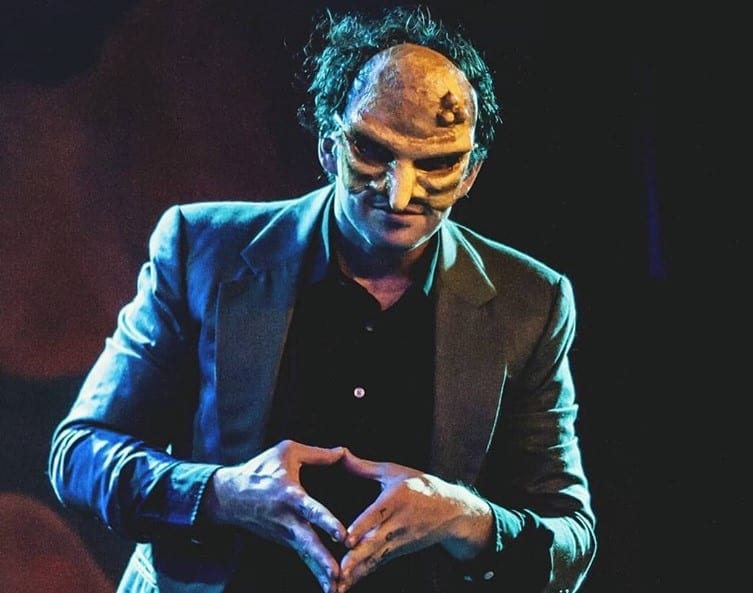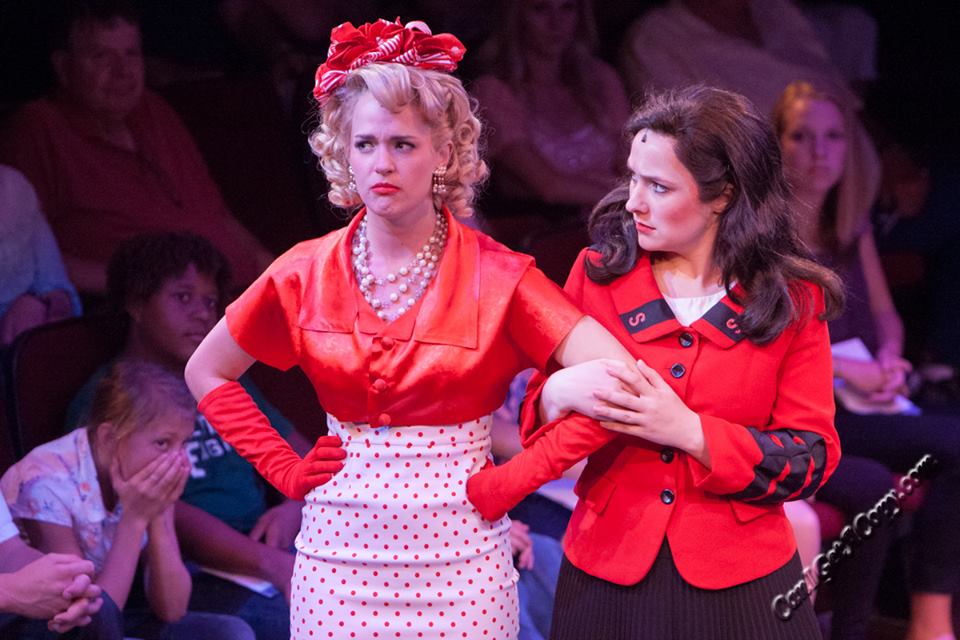PROVO — An Other Theater Company produced Mr. Burns: A Post-Electric Play by Anne Washburn, a show that surrounds the nostalgia of The Simpsons in a post-apocalyptic setting. The writing was interesting and had some very moving scenes. The cast was impressive, and performed in song and dance as well as great acting. Unfortunately, Washburn’s script passed the point of reasonable length.

Show closes August 3, 2019.
The story opens at night with the characters surrounding a trash can fire. Sam (played by Steve Allyn) has a shotgun and is posted as guard. Matt (played by JD Ramsey), Jenny (played by Viviane Thurman), and Maria (played by Nettie Miner) sit around the fire re-telling episodes of their favorite show, The Simpsons. In comes a new guy, Gibson (played by Colt Brown), stirring the others up in fear and defense. Through Gibson, the audience learns that nuclear power plants have been compromised and most people have died. Seven years pass and the same group is putting on a play of a Simpsons episode and they are arguing about other groups getting the rights to it. Before that episode is complete, 75 years have passed, and they are still performing the episode but instead of Sideshow Bob as the villain, Mr. Burns is the evil one. And it is no longer a performance, it’s a religious ritual.
 I was excited at the prospect of seeing a show featuring The Simpsons, one of my favorite TV shows. In the display window of this cute little theater that is situated on the 2nd floor of Provo Towne Centre, they had a TV showing a few clips of cartoon Mr. Burns, cutting into an actor wearing a creepy Mr. Burns Mask. I was anticipating seeing that the whole show, which didn’t happen until the last 20 minutes of the 2 hour 10 minute performance.
I was excited at the prospect of seeing a show featuring The Simpsons, one of my favorite TV shows. In the display window of this cute little theater that is situated on the 2nd floor of Provo Towne Centre, they had a TV showing a few clips of cartoon Mr. Burns, cutting into an actor wearing a creepy Mr. Burns Mask. I was anticipating seeing that the whole show, which didn’t happen until the last 20 minutes of the 2 hour 10 minute performance.
During the first 30 minutes of the play, I wasn’t sure why everyone was so on guard when the script didn’t include any actual danger. When the next scene had the characters acting out the episode, I didn’t understand why they spent so much time on a commercial remake that was much longer than an episode. And I had no idea what the commercial was for, and neither did my date.
 My date, who remembered the “Cape Feare” episode much better than I did, also thought the show could be best in just over an hour. She, too, was confused by a few things, especially why the characters changed the bad guy to Mr. Burns when they knew it was Sideshow Bob. It was not until we watched the episode together afterwards that it was apparent that the change was an attempt to redo it could be funny. (I recommend people see “Cape Fear”e before watching this play.) Still, the point in each scene was missed. I wanted to know why these characters created and showed this with all that energy and effort. For example, Waiting For Godot is a very slow and confusing show until you realize the point and then it is super powerful. Mr. Burns is way more interesting throughout than that but it neglects getting to the big “why.”
My date, who remembered the “Cape Feare” episode much better than I did, also thought the show could be best in just over an hour. She, too, was confused by a few things, especially why the characters changed the bad guy to Mr. Burns when they knew it was Sideshow Bob. It was not until we watched the episode together afterwards that it was apparent that the change was an attempt to redo it could be funny. (I recommend people see “Cape Fear”e before watching this play.) Still, the point in each scene was missed. I wanted to know why these characters created and showed this with all that energy and effort. For example, Waiting For Godot is a very slow and confusing show until you realize the point and then it is super powerful. Mr. Burns is way more interesting throughout than that but it neglects getting to the big “why.”
The set, designed by Janice Chan, was interesting, and the newspapers all over the surrounding walls looked perfect for this setup mixture of classic comic characters and post-apocalypse. I particularly liked the iconic blue sky and white fluffy clouds painted expertly on the back wall. I’m guessing that costumer designer Janae Lafleur created the masks, which were all very intriguing. During the second scene, as the characters dressed as close to the characters in The Simpsons as possible, it was fun to see “Lisa” with a headband with orange bottles rainbowing over it as her spiky hair, and “Marge” with many blue shower scrub balls built in a tower on her head. In the last scene, I loved how the mask for “Bart” had one eyebrow up, and how the “Mr. Burns” mask had the three circular moles on the side of his forehead. The look was engaging and distracted me from the length of the show.
 Most of what directors Kacey Spadafora and Taylor Jack Nelson chose to do was effective. I loved the chalk dust used in place of steam, and how during the fire scene everyone sat still and attentive to Miner’s telling of the nuclear plant, which gave insight into what happened to the world. I also thought the boat scene at the end was set up to be epic, though a tighter script would help the scene reach its potential.
Most of what directors Kacey Spadafora and Taylor Jack Nelson chose to do was effective. I loved the chalk dust used in place of steam, and how during the fire scene everyone sat still and attentive to Miner’s telling of the nuclear plant, which gave insight into what happened to the world. I also thought the boat scene at the end was set up to be epic, though a tighter script would help the scene reach its potential.
Brown did a great job as Mr. Burns. He was so gleefully evil that it was fun to watch him act. I loved his interaction with Mara Lefler, playing Bart. She was confident most of the time, and I was able to see Bart’s personality in her as she spoke. (Some of the other actors failed to have the classic Simpsons characters’ personality shine through.) Miner was also engaging when she spoke, and she seemed to fit the personality of her main character, Maria, naturally. I appreciated the artistic talent of the actors, especially as they were required to sing for a huge portion of this show, and sing as people who weren’t properly trained.
However, some there was too much incoherence in some of the performances. I also thought with my history of watching so much of The Simpsons, I would easily follow what they were talking about. Most of the time, the script was either not accurate enough for me to realize what episode the characters were discussing, or the imitation was just too watered down. I didn’t even know Miner was playing Mrs. Krabappel until I saw it in the playbill after the show.
Though this show is interesting and has some very talented acting, I wouldn’t want to see it again until it was more concise. I can handle an hour of this kind of show, but not more. I’m not against long plays, but this one in particular needs to be shorter for it to be enjoyable. However, I am very impressed with this company and what it is able to create, so I anticipate seeing more of their productions and am happy they have chosen to provide deep straight plays.





